ESP VOLVO XC90 TWIN ENGINE 2019 Owner's Guide
[x] Cancel search | Manufacturer: VOLVO, Model Year: 2019, Model line: XC90 TWIN ENGINE, Model: VOLVO XC90 TWIN ENGINE 2019Pages: 697, PDF Size: 10.33 MB
Page 325 of 697

DRIVER SUPPORT
}}
* Option/accessory. 323
Setting a time interval for Pilot
Assist
Pilot Assist
can be set to different time intervals.
Different time intervals to the
vehicle ahead can be selected
and are shown in the instru-
ment panel as 1–5 horizontal
bars. The more bars, the longer
the time interval. One bar rep-
resents an interval of
approx. 1 second to the vehicle ahead. 5 bars
represents approx. 3 seconds.
NOTE When the symbol in the instrument panel
shows a vehicle and a steering wheel, Pilot
Assist follows a vehicle ahead at a preset
time interval.
When only a steering wheel is shown, there is
no vehicle ahead within a reasonable dis-
tance. Controls for setting a time interval
60
. Reduce the time interval
Increase the time interval
Distance indicator
– Press the (1) or (2) button to decrease or
increase the time interval.
>
The distance indicator (3) shows the cur-
rent time interval.
In order to follow the vehicle ahead as smoothly
as possible, Pilot Assist allows the time interval to
vary considerably in certain situations. For exam-
ple, at low speeds and short distances to the
vehicle ahead, Pilot Assist increases the time
interval slightly.
NOTE
The greater the vehicles' speed, the
greater the distance between them for a
set time interval.
Only use the time intervals permitted by
local traffic regulations.
If Pilot Assist does not seem to respond
with a speed increase when activated, it
may be because the time interval to the
vehicle ahead is shorter than the set time
interval.
WARNING
Only use a time interval suitable for the
current traffic conditions.
The driver should be aware that short
time intervals give them limited time to
react and act to any unforeseen traffic
situation.
Setting how Pilot Assist should
maintain distance* to the vehicle ahead
The driver can choose different drive modes to
determine how Pilot Assist should maintain a
time interval to the vehicle ahead. Settings are
made using the DRIVE MODE controls. 60
Note: This illustration is general and details may vary depending on mod\
el.
Page 331 of 697
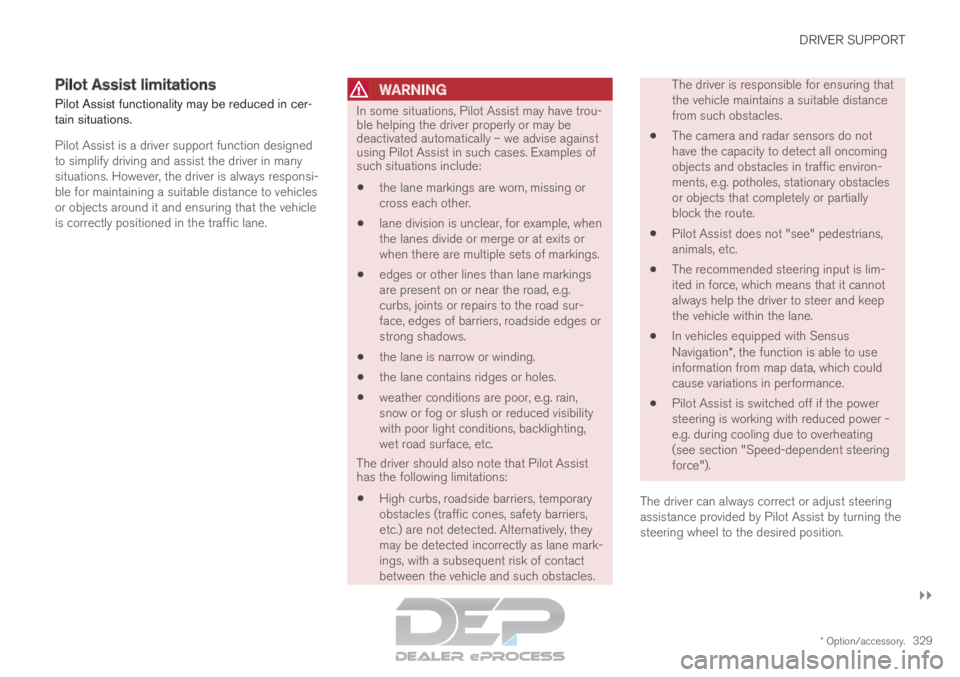
DRIVER SUPPORT
}}
* Option/accessory. 329
Pilot Assist limitations
Pilot Assist functionality may be reduced in cer-
tain situations.
Pilot Assist is a driver support function designed
to simplify driving and assist the driver in many
situations. However, the driver is always responsi-
ble for maintaining a suitable distance to vehicles
or objects around it and ensuring that the vehicle
is correctly positioned in the traffic lane.
WARNING In some situations, Pilot Assist may have trou-
ble helping the driver properly or may be
deactivated automatically – we advise against
using Pilot Assist in such cases. Examples of
such situations include:
the lane markings are worn, missing or
cross each other.
lane division is unclear, for example, when
the lanes divide or merge or at exits or
when there are multiple sets of markings.
edges or other lines than lane markings
are present on or near the road, e.g.
curbs, joints or repairs to the road sur-
face, edges of barriers, roadside edges or
strong shadows.
the lane is narrow or winding.
the lane contains ridges or holes.
weather conditions are poor, e.g. rain,
snow or fog or slush or reduced visibility
with poor light conditions, backlighting,
wet road surface, etc.
The driver should also note that Pilot Assist
has the following limitations:
High curbs, roadside barriers, temporary
obstacles (traffic cones, safety barriers,
etc.) are not detected. Alternatively, they
may be detected incorrectly as lane mark-
ings, with a subsequent risk of contact
between the vehicle and such obstacles. The driver is responsible for ensuring that
the vehicle maintains a suitable distance
from such obstacles.
The camera and radar sensors do not
have the capacity to detect all oncoming
objects and obstacles in traffic environ-
ments, e.g. potholes, stationary obstacles
or objects that completely or partially
block the route.
Pilot Assist does not "see" pedestrians,
animals, etc.
The recommended steering input is lim-
ited in force, which means that it cannot
always help the driver to steer and keep
the vehicle within the lane.
In vehicles equipped with Sensus
Navigation*, the function is able to use
information from map data, which could
cause variations in performance.
Pilot Assist is switched off if the power
steering is working with reduced power -
e.g. during cooling due to overheating
(see section "Speed-dependent steering
force").
The driver can always correct or adjust steering
assistance provided by Pilot Assist by turning the
steering wheel to the desired position.
Page 335 of 697

DRIVER SUPPORT
}}
333
Radar sensor limitations
The radar sensor used by several of the driver
support functions has certain limitations, which
also affect the functions using the radar sensor.
Obstructed camera The area marked in the illustration must be kept free of
decals, objects, solar film, etc.
65 The radar sensor is located on the upper interior
section of the windshield along with the camera.
CAUTION Do not place, affix or mount anything on the
inside or outside of the windshield, or in front
of or around the camera and radar unit – this
could disrupt camera and radar-based func-
tions.
It could cause functions to be reduced, deac-
tivated completely or produce an incorrect
function response. If this symbol and the message
"
Windscreen sensor Sensor
blocked, see Owner's manual" is
displayed in the instrument panel, it
means that the camera and radar sensor are
unable to detect other vehicles, cyclists, pedes-
trians and large animals in front of the vehicle
and that the vehicle's camera and radar-based
functions may be obstructed, reduced, completely
disabled or providing inaccurate responses. The following table shows some of the situations that can cause the mess\
age to be displayed, and suggested actions:
Cause
Action
The area of the windshield in front of the camera/radar sensor is dirty \
or
covered by ice or snow. Clean the windshield in front of the camera/radar sensor and remove dirt\
, ice
and snow.
Thick fog, heavy rain or snow is blocking the radar signals or the camer\
a's
range of visibility. No action. Heavy precipitation may sometimes prevent the camera/radar se\
nsor
from functioning.65
Note: This illustration is general and details may vary depending on mod\
el.
Page 337 of 697

DRIVER SUPPORT
335
High temperaturesIf the temperature in the passenger compartment
is very high, the camera/radar sensor will switch
off temporarily for approx. 15 minutes after the
engine is started to protect its electronic compo-
nents. When the temperature has cooled suffi-
ciently, the camera/radar sensor will automati-
cally restart.Damaged windshield
CAUTIONIf there are cracks, scratches or stone chips
on the windshield in front of any of the cam-
era and radar unit "windows" and this covers
an area of about 0.5 × 3.0 mm
(0.02 × 0.12 in.) or more, contact a workshop
to have the windshield replaced – an author-
ized Volvo workshop is recommended.
Failure to take action could result in reduced
performance for the driver support systems
that use the camera and radar unit.
It could cause functions to be reduced, deac-
tivated completely or produce an incorrect
function response.
To avoid the risk of loss of function, malfunc-
tion or reduced function of the driver support
systems that use the radar unit, the following
also apply:
Volvo advises against repairing cracks,
scratches or stone chips in the area in
front of the camera and radar unit – the
entire windshield should instead be
replaced.
Before replacing the windshield, contact
an authorized Volvo workshop to verify
that the right windshield has been
ordered and installed.
The same type of windshield wipers or
wipers approved by Volvo should be used
for replacement.
CAUTION If the windshield is replaced, the camera and
radar unit must be recalibrated by a workshop
to help ensure proper functioning of all of the
vehicle's camera and radar-based systems –
an authorized Volvo workshop is recom-
mended.
Related information
Radar sensor (p. 332)
Page 338 of 697
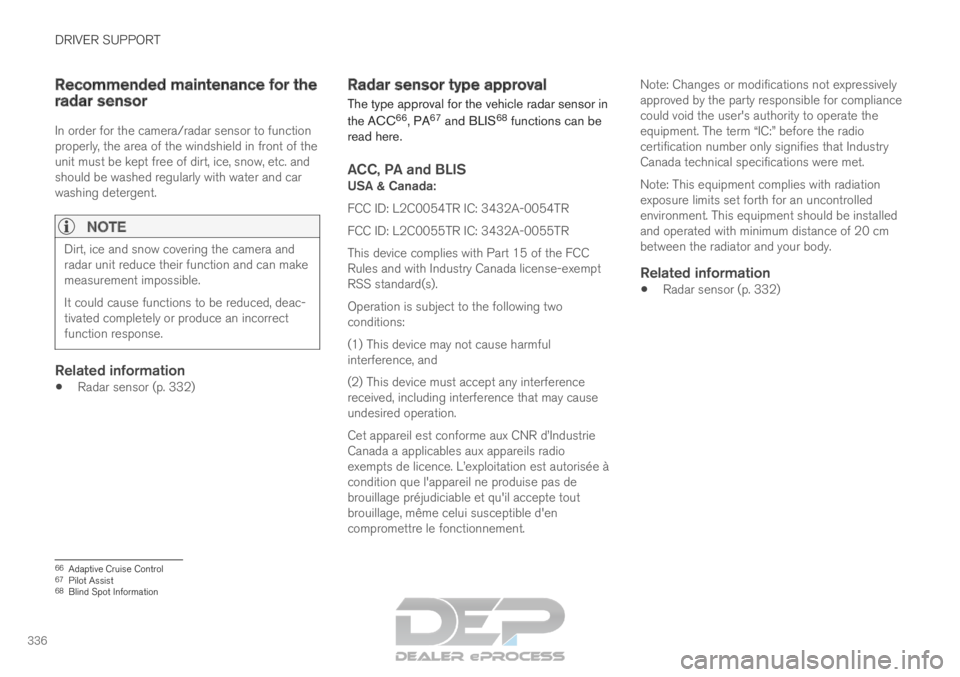
DRIVER SUPPORT
336Recommended maintenance for the
radar sensor
In order for the camera/radar sensor to function
properly, the area of the windshield in front of the
unit must be kept free of dirt, ice, snow, etc. and
should be washed regularly with water and car
washing detergent.
NOTE
Dirt, ice and snow covering the camera and
radar unit reduce their function and can make
measurement impossible.
It could cause functions to be reduced, deac-
tivated completely or produce an incorrect
function response.
Related information
Radar sensor (p. 332) Radar sensor type approval
The type approval for the vehicle radar sensor in
the ACC 66
, PA 67
and BLIS 68
functions can be
read here.
ACC, PA and BLISUSA & Canada:
FCC ID: L2C0054TR IC: 3432A-0054TR
FCC ID: L2C0055TR IC: 3432A-0055TR
This device complies with Part 15 of the FCC
Rules and with Industry Canada license-exempt
RSS standard(s).
Operation is subject to the following two
conditions:
(1) This device may not cause harmful
interference, and
(2) This device must accept any interference
received, including interference that may cause
undesired operation.
Cet appareil est conforme aux CNR d
Page 341 of 697

DRIVER SUPPORT
}}}}
339 Cause
Action
The area of the windshield in front of the camera/radar sensor is
dirty or covered by ice or snow. Clean the windshield in front of the camera/radar sensor and remove dirt\
, ice and
snow.
Thick fog, heavy rain or snow is blocking the radar signals or the
camera's range of visibility. No action. Heavy precipitation may sometimes prevent the camera/radar se\
nsor from
functioning.
Water or snow is spraying/swirling up and blocking the radar signals
or the camera's range of visibility. No action. Very wet or snow-covered roads may sometimes prevent the came\
ra/
radar sensor from functioning.
There is dirt between the inside of the windshield and the camera/
radar sensor. Consult a workshop to have the area of the windshield on the inside of t\
he camera's
casing cleaned. An authorized Volvo workshop is recommended.
Bright sunlight. No action. The camera/radar sensor will reset automatically when lightin\
g conditions
improve.
NOTEKeep the windshield in front of the camera
and radar unit clean.
High temperaturesIf the temperature in the passenger compartment
is very high, the camera/radar sensor will switch
off temporarily for approx. 15 minutes after the
engine is started to protect its electronic compo-
nents. When the temperature has cooled suffi-
ciently, the camera/radar sensor will automati-
cally restart.
Damaged windshield
CAUTION
If there are cracks, scratches or stone chips
on the windshield in front of any of the cam-
era and radar unit "windows" and this covers
an area of about 0.5 × 3.0 mm
(0.02 × 0.12 in.) or more, contact a workshop
to have the windshield replaced – an author-
ized Volvo workshop is recommended.
Failure to take action could result in reduced
performance for the driver support systems
that use the camera and radar unit. It could cause functions to be reduced, deac-
tivated completely or produce an incorrect
function response.
To avoid the risk of loss of function, malfunc-
tion or reduced function of the driver support
systems that use the radar unit, the following
also apply:
Volvo advises against repairing cracks,
scratches or stone chips in the area in
front of the camera and radar unit – the
entire windshield should instead be
replaced.
Before replacing the windshield, contact
an authorized Volvo workshop to verify
Page 343 of 697
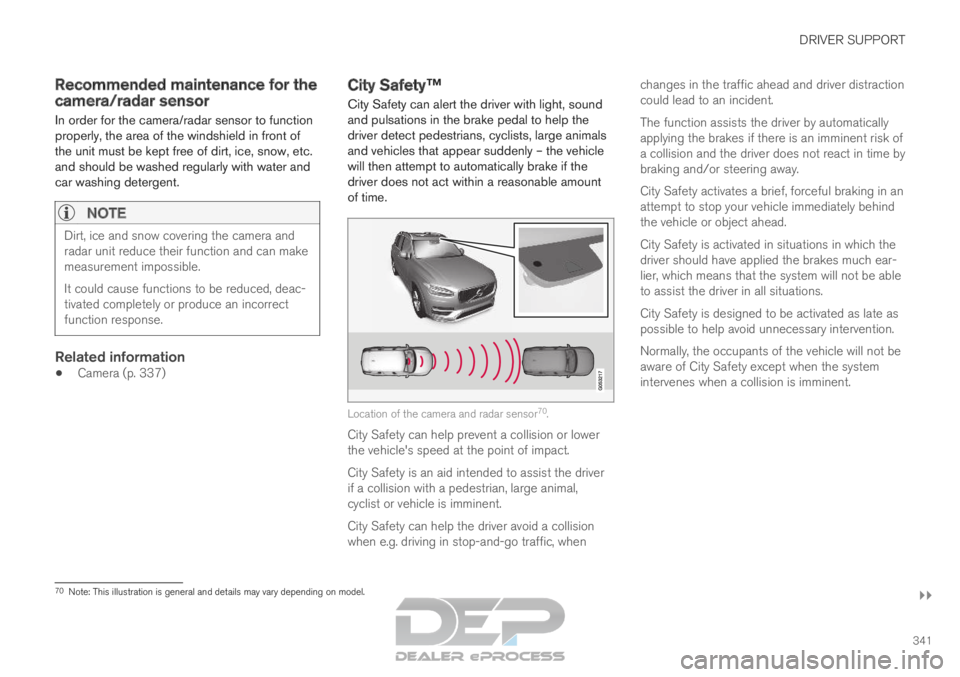
DRIVER SUPPORT
}}
341
Recommended maintenance for the
camera/radar sensor
In order for the camera/radar sensor to function
properly, the area of the windshield in front of
the unit must be kept free of dirt, ice, snow, etc.
and should be washed regularly with water and
car washing detergent.
NOTE Dirt, ice and snow covering the camera and
radar unit reduce their function and can make
measurement impossible.
It could cause functions to be reduced, deac-
tivated completely or produce an incorrect
function response.
Related information
Camera (p. 337) City Safety™
City Safety can alert the driver with light, sound
and pulsations in the brake pedal to help the
driver detect pedestrians, cyclists, large animals
and vehicles that appear suddenly – the vehicle
will then attempt to automatically brake if the
driver does not act within a reasonable amount
of time. Location of the camera and radar sensor
70
.
City Safety can help prevent a collision or lower
the vehicle's speed at the point of impact.
City Safety is an aid intended to assist the driver
if a collision with a pedestrian, large animal,
cyclist or vehicle is imminent.
City Safety can help the driver avoid a collision
when e.g. driving in stop-and-go traffic, when changes in the traffic ahead and driver distraction
could lead to an incident.
The function assists the driver by automatically
applying the brakes if there is an imminent risk of
a collision and the driver does not react in time by
braking and/or steering away.
City Safety activates a brief, forceful braking in an
attempt to stop your vehicle immediately behind
the vehicle or object ahead.
City Safety is activated in situations in which the
driver should have applied the brakes much ear-
lier, which means that the system will not be able
to assist the driver in all situations.
City Safety is designed to be activated as late as
possible to help avoid unnecessary intervention.
Normally, the occupants of the vehicle will not be
aware of City Safety except when the system
intervenes when a collision is imminent.
70
Note: This illustration is general and details may vary depending on mod\
el.
Page 344 of 697
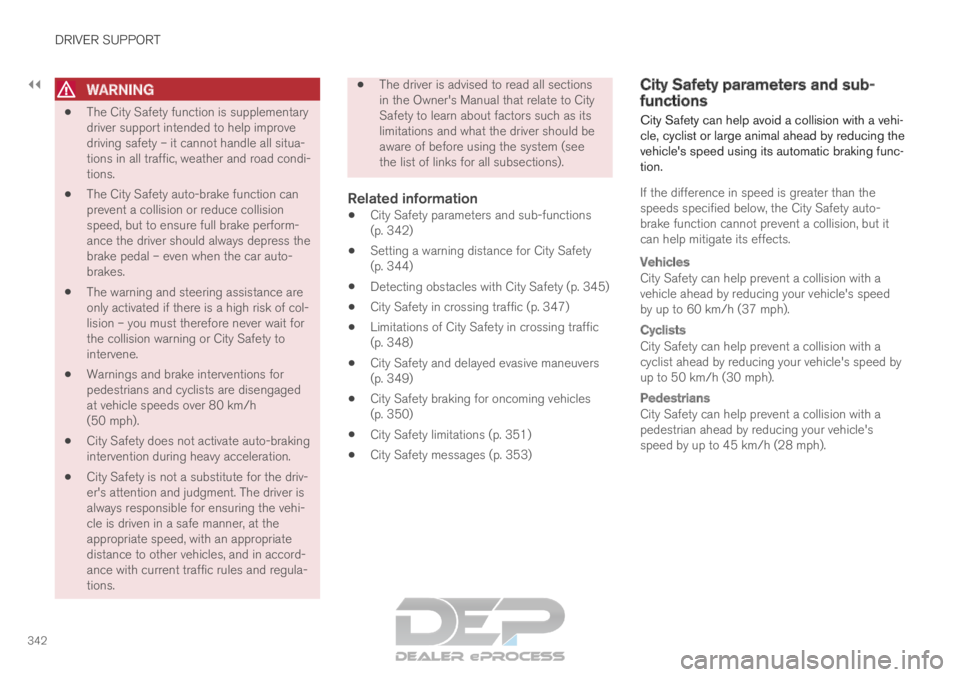
||DRIVER SUPPORT
342
WARNING
The City Safety function is supplementary
driver support intended to help improve
driving safety – it cannot handle all situa-
tions in all traffic, weather and road condi-
tions.
The City Safety auto-brake function can
prevent a collision or reduce collision
speed, but to ensure full brake perform-
ance the driver should always depress the
brake pedal – even when the car auto-
brakes.
The warning and steering assistance are
only activated if there is a high risk of col-
lision – you must therefore never wait for
the collision warning or City Safety to
intervene.
Warnings and brake interventions for
pedestrians and cyclists are disengaged
at vehicle speeds over 80 km/h
(50 mph).
City Safety does not activate auto-braking
intervention during heavy acceleration.
City Safety is not a substitute for the driv-
er's attention and judgment. The driver is
always responsible for ensuring the vehi-
cle is driven in a safe manner, at the
appropriate speed, with an appropriate
distance to other vehicles, and in accord-
ance with current traffic rules and regula-
tions.
The driver is advised to read all sections
in the Owner's Manual that relate to City
Safety to learn about factors such as its
limitations and what the driver should be
aware of before using the system (see
the list of links for all subsections).
Related information
City Safety parameters and sub-functions
(p. 342)
Setting a warning distance for City Safety
(p. 344)
Detecting obstacles with City Safety (p. 345)
City Safety in crossing traffic (p. 347)
Limitations of City Safety in crossing traffic
(p. 348)
City Safety and delayed evasive maneuvers
(p. 349)
City Safety braking for oncoming vehicles
(p. 350)
City Safety limitations (p. 351)
City Safety messages (p. 353) City Safety parameters and sub-
functions
City Safety can help avoid a collision with a vehi-
cle, cyclist or large animal ahead by reducing the
vehicle's speed using its automatic braking func-
tion.
If the difference in speed is greater than the
speeds specified below, the City Safety auto-
brake function cannot prevent a collision, but it
can help mitigate its effects.
Vehicles
City Safety can help prevent a collision with a
vehicle ahead by reducing your vehicle's speed
by up to 60 km/h (37 mph).
Cyclists
City Safety can help prevent a collision with a
cyclist ahead by reducing your vehicle's speed by
up to 50 km/h (30 mph).
Pedestrians
City Safety can help prevent a collision with a
pedestrian ahead by reducing your vehicle's
speed by up to 45 km/h (28 mph).
Page 348 of 697
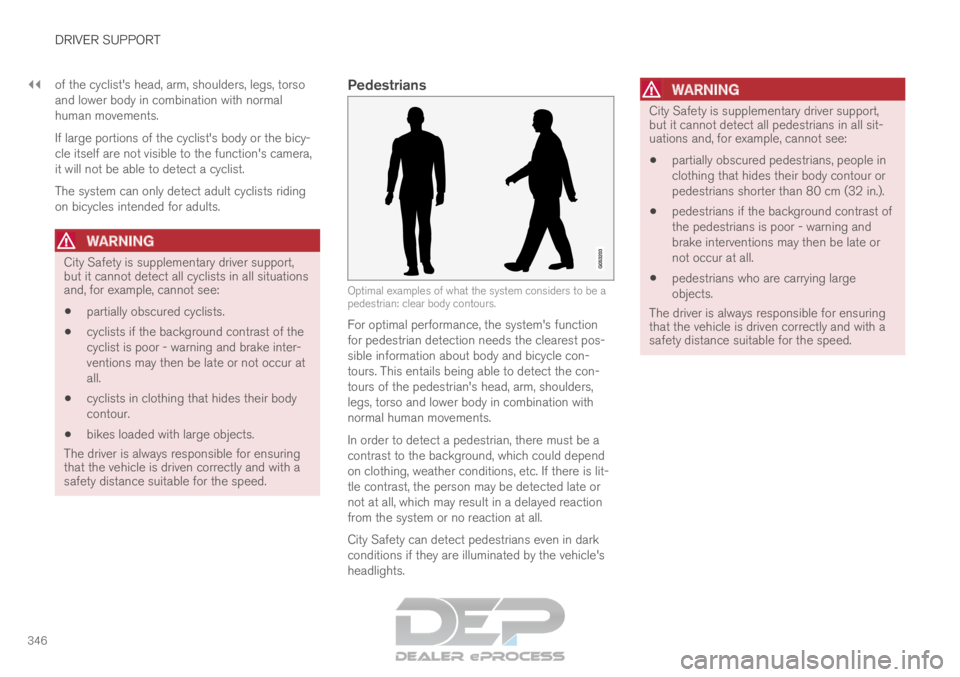
||DRIVER SUPPORT
346
of the cyclist's head, arm, shoulders, legs, torso
and lower body in combination with normal
human movements.
If large portions of the cyclist's body or the bicy-
cle itself are not visible to the function's camera,
it will not be able to detect a cyclist.
The system can only detect adult cyclists riding
on bicycles intended for adults.
WARNING
City Safety is supplementary driver support,
but it cannot detect all cyclists in all situations
and, for example, cannot see:
partially obscured cyclists.
cyclists if the background contrast of the
cyclist is poor - warning and brake inter-
ventions may then be late or not occur at
all.
cyclists in clothing that hides their body
contour.
bikes loaded with large objects.
The driver is always responsible for ensuring
that the vehicle is driven correctly and with a
safety distance suitable for the speed.
Pedestrians Optimal examples of what the system considers to be a
pedestrian: clear body contours.
For optimal performance, the system's function
for pedestrian detection needs the clearest pos-
sible information about body and bicycle con-
tours. This entails being able to detect the con-
tours of the pedestrian's head, arm, shoulders,
legs, torso and lower body in combination with
normal human movements.
In order to detect a pedestrian, there must be a
contrast to the background, which could depend
on clothing, weather conditions, etc. If there is lit-
tle contrast, the person may be detected late or
not at all, which may result in a delayed reaction
from the system or no reaction at all.
City Safety can detect pedestrians even in dark
conditions if they are illuminated by the vehicle's
headlights.WARNING City Safety is supplementary driver support,
but it cannot detect all pedestrians in all sit-
uations and, for example, cannot see:
partially obscured pedestrians, people in
clothing that hides their body contour or
pedestrians shorter than 80 cm (32 in.).
pedestrians if the background contrast of
the pedestrians is poor - warning and
brake interventions may then be late or
not occur at all.
pedestrians who are carrying large
objects.
The driver is always responsible for ensuring
that the vehicle is driven correctly and with a
safety distance suitable for the speed.
Page 349 of 697
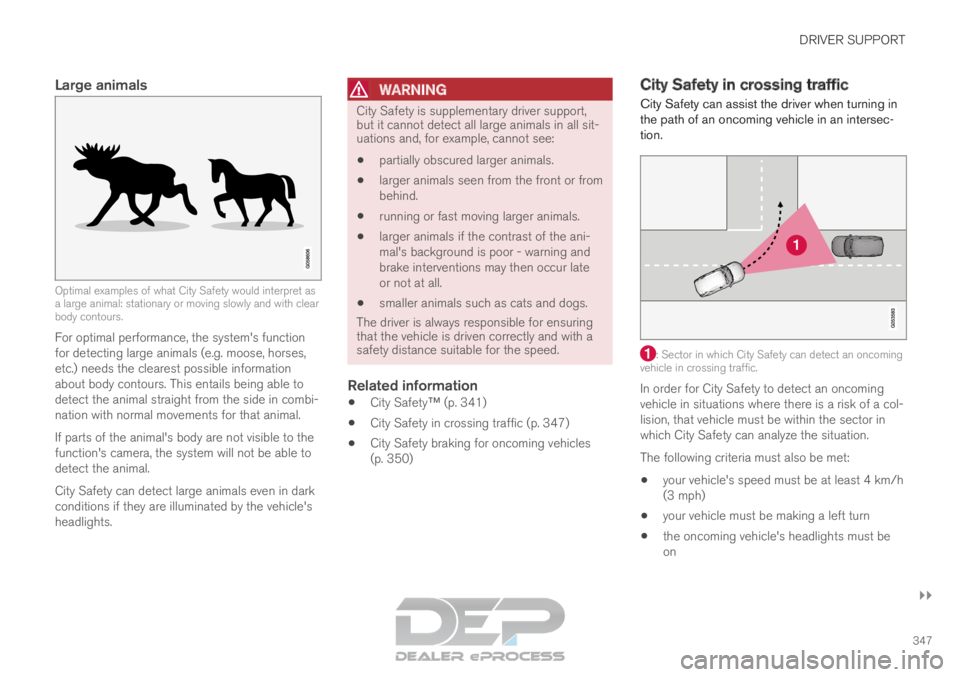
DRIVER SUPPORT
}}
347
Large animals Optimal examples of what City Safety would interpret as
a large animal: stationary or moving slowly and with clear
body contours.
For optimal performance, the system's function
for detecting large animals (e.g. moose, horses,
etc.) needs the clearest possible information
about body contours. This entails being able to
detect the animal straight from the side in combi-
nation with normal movements for that animal.
If parts of the animal's body are not visible to the
function's camera, the system will not be able to
detect the animal.
City Safety can detect large animals even in dark
conditions if they are illuminated by the vehicle's
headlights.WARNING City Safety is supplementary driver support,
but it cannot detect all large animals in all sit-
uations and, for example, cannot see:
partially obscured larger animals.
larger animals seen from the front or from
behind.
running or fast moving larger animals.
larger animals if the contrast of the ani-
mal's background is poor - warning and
brake interventions may then occur late
or not at all.
smaller animals such as cats and dogs.
The driver is always responsible for ensuring
that the vehicle is driven correctly and with a
safety distance suitable for the speed.
Related information
City Safety™ (p. 341)
City Safety in crossing traffic (p. 347)
City Safety braking for oncoming vehicles
(p. 350) City Safety in crossing traffic
City Safety
can assist the driver when turning in
the path of an oncoming vehicle in an intersec-
tion. : Sector in which City Safety can detect an oncoming
vehicle in crossing traffic.
In order for City Safety to detect an oncoming
vehicle in situations where there is a risk of a col-
lision, that vehicle must be within the sector in
which City Safety can analyze the situation.
The following criteria must also be met:
your vehicle's speed must be at least 4 km/h
(3 mph)
your vehicle must be making a left turn
the oncoming vehicle's headlights must be
on